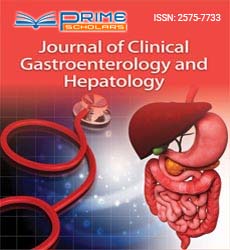Perspective - (2022) Volume 6, Issue 12
Tumors Caused at the Bile Ducts and it’s Major Effects on the Digestive System
Victoria Arlen*
Department of Cancer Epidemiology and Genetics, University of Houston, USA
*Correspondence:
Victoria Arlen,
Department of Cancer Epidemiology and Genetics, University of Houston,
USA,
Email:
Received: 30-Nov-2022, Manuscript No. IPJCGH-23-15589;
Editor assigned: 02-Dec-2022, Pre QC No. IPJCGH-23-15589 (PQ);
Reviewed: 16-Dec-2022, QC No. IPJCGH-23-15589;
Revised: 21-Dec-2022, Manuscript No. IPJCGH-23-15589 (R);
Published:
28-Dec-2022, DOI: 10.36648/2575-7733.6.12.60
Introduction
Cholangiocarcinoma is a term used to describe a class of tumours
that start in the bile ducts. The small intestine is connected
to the liver and gallbladder by bile ducts, which are
branching tubes. They transport bile, a substance that facilitates
the breakdown of lipids found in diet. Bile is created in
the liver when food is consumed, and it is then stored in the
gallbladder before being expelled in the small intestine. The
proximity of a cholangiocarcinoma to the liver determines its
classification. In the liver, intrahepatic cholangiocarcinoma first
appears in the small bile ducts. Less than 10% of cases of the
disease are in this least frequent form.
Description
The right and left major bile ducts merge and leave the liver
at the hilum, where perihilar cholangiocarcinoma, a Klatskin
tumour, first appears. This most prevalent form of the disease
accounts for more than half of all cases. The remaining instances
are distal cholangiocarcinomas, which start in bile ducts
outside the liver. The perihilar and distal forms of the illness,
which develop outside the liver, are referred to as extrahepatic
cholangiocarcinoma.
The three types of cholangiocarcinoma rarely exhibit early-
stage symptoms, and this type of cancer is often not identified
until it has advanced into tissues outside of the bile ducts.
There are usually symptoms when the tumour obstructs the
bile ducts. The most typical sign is jaundice, which causes
the skin and the whites of the eyes to turn yellow. Additional
symptoms include extreme exhaustion, itching, and dark urine,
lack of appetite, unexpected weight loss, abdominal pain, and
light-colored, oily stools. These symptoms are referred to as “non-specific” since they could be signs of numerous illnesses.
The majority of those are over 65 who have cholangiocarcinoma.
Effective treatment for this cancer can be difficult because
it is frequently only found after it has spread. Affected individuals
may live for few months to several years after being diagnosed,
depending on the location and stage of the cancer.
A tumour is formed when key genes, such as those that control
cell division, accumulate mutations, causing cells to expand
and divide uncontrollably. In the majority of cholangiocarcinoma
cases, these genetic alterations are acquired throughout
the course of a person’s lifetime and are exclusively present in
the bile duct cells that give rise to the tumour. Genetic alterations
caused by somatic mutations are not transferred from
parent to child. Numerous somatic mutations in multiple genes
have been linked to cholangiocarcinoma. Some of these genes
function as tumour suppressors and support tightly controlled
cell growth and division. Cancer is characterised by the uncontrolled
growth and division of cells caused by mutations or deletions
in tumour suppressor genes.
Conclusion
Oncogenes are extra genes linked to cholangiocarcinoma; if
they are activated abnormally, they have the capacity to change
healthy cells into malignant ones. Cholangiocarcinoma somatic
mutations may provide information on the rate of growth and
metastasis of the disease as well as the most potent therapeutic
approaches. According to study, a mix of genetic, environmental,
and behavioural factors may affect a person’s chance
of developing cholangiocarcinoma. The majority of those who
contract the illness, however, do not have any of the known
risk factors.
Citation: Arlen V (2022) Tumors Caused at the Bile Ducts and it’s Major Effects on the Digestive System. J Clin Gastroenterol
Hepatol. 6:60.
Copyright: © 2022 Arlen V. This is an open-access article distributed under the terms of the Creative Commons Attribution License,
which permits unrestricted use, distribution, and reproduction in any medium, provided the original author and source
are credited.

